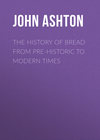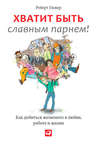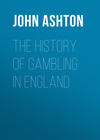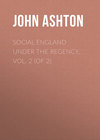Читать книгу: «The History of Bread From Pre-historic to Modern Times», страница 3
Historic, too, is the Chupatee, for by its means the message was sent round throughout the length and breadth of British India for the rising against the English rule – known as the Indian Mutiny. Its true meaning was not at first understood, as we may read in the Indian correspondence of the Times, dated Bombay, March 3, 1857: ‘From Cawnpore to Allahabad, and onwards towards the great cities of the North-West, the chokedars, or policemen, have been of late spreading from village to village – at whose command, or for what object, they themselves, it is said, are ignorant – little plain cakes of wheaten flour. The number of cakes, and the mode of their transmission, is uniform. Chokedar of village A enters village B, and, addressing its chokedar, commits to his charge two cakes, with directions to have other two similar to them prepared; and, leaving the old in his own village, to hie with the new to village C, and so on. English authorities of the districts through which these edibles passed looked at, handled, and probably tasted them; and finding them, upon the evidence of all their senses, harmless, reported accordingly to the Government. And it appears, I think, with tolerable clearness, that the mysterious mission is not of political but of superstitious origin; and is directed simply to the warding off of diseases, such as the choleraic visitation of twelve months ago, in which point of view it is noteworthy and characteristic, and not unworthy to be remembered together with last year’s grim and picturesque legend of the horseman, who rode down to the river at dead of night and was ferried across, announcing that the pestilence was in his train.’
Apropos of Indian flour, Col. Meadows Taylor, in The Story of My Life, tells a story anent the adulteration of flour in India.
‘During that day my tent was beset by hundreds of pilgrims and travellers, crying loudly for justice against the flour-sellers, who not only gave short weight in flour, but adulterated it so distressingly with sand that the cakes made with it were uneatable, and had to be thrown away. That evening I told some reliable men of my escort to go quietly into the bazaars and each buy flour at a separate shop, being careful to note whose shop it was.
‘The flour was brought to me. I tested every sample, and found it full of sand as I passed it under my teeth. I then desired that all the persons named in my list should be sent to me with their baskets of flour, their weights and scales. Shortly afterwards they arrived, evidently suspecting nothing, and were placed in a row seated on the grass before my tent.
‘“Now,” said I gravely, “each of you is to weigh out a ser (two pounds) of your flour,” which was done. “Is it for the pilgrims?” asked one.
‘“No,” said I quietly, though I had much difficulty to keep my countenance. “You must eat it yourselves.”
‘They saw that I was in earnest, and offered to pay any fine that I imposed.
‘“Not so,” I returned, “you have made many eat your flour; why should you object to eat it yourselves?”
‘They were horribly frightened, and, amid the jeers and screams of laughter of the bystanders, some of them actually began to eat, spluttering out the half-moistened flour, which could be heard crunching between their teeth. At last some of them flung themselves on their faces, abjectly beseeching pardon.
‘“Swear!” I cried, “swear by the Holy Mother in yonder temple that you will not fill the mouths of her worshippers with dirt! You have brought this on yourselves, and there is not a man in all the country who will not laugh at the bunnais (flour-sellers) who could not eat their own flour because it broke their teeth.”
‘So this episode terminated, and I heard no more complaints of bad flour.’
The Indian flour mill is very primitive, consisting of two great mill-stones, of which the lower is fast, and the upper is usually turned by two women, who feed the wheat by handfuls into a hole which passes through the stone. The meal so obtained is simply mixed with palm yeast, and baked in very hot ovens, which have been heated for several days. The small European householder finds it more convenient to patronise the Mohammedan bakers, of whom, however, the bread has to be ordered in advance. Sometimes two or three English families combine, and hire a baker, paying him a monthly salary, and providing him with the raw material.
The yeast mentioned above is made from the sap of the date palm. In April, before the flowers appear, a Hindoo climbs the naked trunk – for the leaves, as in all palm trees, are borne on the top. The man’s feet are bound together by a rope, and about his hips are fastened two pots for the reception of the sap. As he climbs, he calls out, ‘Darpor, darpor ata hain,’ which, being interpreted, means, ‘The palm-tapper is coming.’ This is for the benefit of the Mohammedan women who might be sitting unveiled in the courtyards of the houses exposed to the view of the climber after he has risen above the tops of the walls. A tapper who once fails to give this warning cry is thenceforth forbidden to ply his trade. When the tapper has reached the crown of the tree he cuts two gashes in opposite sides of the trunk with an axe, which he has carried up in his mouth. Then he fastens the pots under the gashes and descends. The full pots are taken away and empty ones put in their place twice daily. The sap has a sweet taste, and contains some alcohol even when fresh. After standing in the sun in great earthen pots for a few days it begins to ferment, after which it deposits a thick white substance. This, taken at the proper time, is used as yeast.
But rice is, in India, the staff of life, being used to a greater extent than any grain in Europe. It is, in fact, the food of the highest and the lowest, the principal harvest of every climate. Its production, generally speaking, is only limited by the means of irrigation, which is essential to its growth. The ground is prepared in March and April; the seed is sown in May and reaped in August. If circumstances are favourable there are other harvests, one between July and November, another between January and April. These also sometimes consist of rice, but more commonly of other grain or pulse. In some parts millet is used as food. Many are the ways of cooking rice – there are powder of cucumber seeds and rice, lime juice and rice, orange juice and rice, jack fruit and rice, rice and milk, and sweet cakes made of rice flour, with or without green ginger.
The Bombay baker is a man of a different stamp altogether to the Bengal baker. He is invariably a Goanese and a native Christian, and adopts his profession not from choice but by heredity. For generations past his fathers have been bakers, and have, in accordance with the rules of the Society of Bakers, to which they must have belonged, studied some portion at least of the art of manufacturing bread. The Bombay baker is, moreover, a man of substance. To begin with, he grows his own wheat, and has it conveyed to his factories, where as many as 200 hands are employed in converting it into raw material for cooking. He retains a staff of chefs, who also hail from Goa, and who attend exclusively to the baking. Greater comparative intelligence and a love for his trade enable him to turn out a far superior article to that of his ignorant contemporary in Upper India; but even in Bombay the same fault has to be found with the manufacturer: either the bread is too fine, or it is too ‘brown’ – that is, it contains too much bran.
CHAPTER VI
BREAD IN EUROPE AND AMERICA
Olaus Magnus, Archbishop of Upsala, who lived in the first half of the 16th century, has left behind him, in his Historia de Gentibus Septentrionalibus, a long and lucid account of Scandinavian life and manners. Respecting harvest, he tells us that in the Northern countries, in many fields of the Visigoths, on that part that lies southward, barley is ripe and mown in 36 days from the date of sowing – that is, from the end of June to the middle of August, and sometimes sooner; and other corn sown in the beginning of May is reaped in the middle of August – ‘by the mutual help of the countrymen, not with any great pains, but with alacrity and willing minds, lest cold wind should blow upon it and blast the corn. And they desire no other reward for their daily labour than a merry feast at night, where the young people of both sexes, by reason of their faithful labours in the field, by the judgment, consent, and permission of their provident parents, are made choice of for to be married.’
He tells us that the farther North you go the less wheat is grown, but there is more towards the South, the Swedes having plenty of wheat but more rye. ‘But the Goths, both East and West, who feed on barley and oats, have an infinite abundance given them by the mercy of God. Yet there is use made of all these sorts of corn in both places. But the Swedes provide most of rye, where their women know so well how to winnow rye, that for colour, taste, and for health it surpasses the goodness of wheat.’
In order to preserve their corn they carefully dried it. ‘On the hottest days, when the sun shines strong, they spread cloths like ships’ sails, or else the sails themselves, upon the ground, or on the tops of mountains where there is no grass, and they lay the corn out to dry for six, or more, or fewer days, as the sun shines hot; then when it is cleaned they lay it up in vessels of oak, or else they grind it, and so lay it up safe, and when it is so dried it will last good for years. But if it be not ground meal, but corn, it is convenient once a year to set it in the sun to be again dried, and thus new-dried corn may be mingled with it prudently. But the meal thrust into the oaken vessels, or tuns, by strong ramming it in with wooden mallets, and laid up in a dry place, will last many years, and never be worm-eaten.’
He also discourses on the variety of mills for grinding corn in use. How there was the windmill, that turned by running water, by horse-power, by hands and feet – backwards and forwards, like the pre-historic mealing stones, and also the quern; but he mostly extols the windmills of Holland.
The grain being ground, it was ready for making into bread, and he minutely describes the operation – how it was kneaded into a round shape, then rolled very thin, and finally baked on a sheet of iron, like a warrior’s shield, supported by a tripod, and heated by a slow fire – in fact, the griddle, or girdle, cakes of North Britain. But there was other bread which was baked in an oven; and here the artist seems to have drawn somewhat upon his imagination for his cockroaches and blackbeetles. It seems that bread was not sold by weight, and that they were in the habit, about Christmas time, of making what we should call dough babies, about the size of a five-year-old child, of which they made presents, and similar, but smaller, babies of wheat-flour, which they sold.
They also made a gingerbread of flour, honey, and spices, which travellers in the winter made use of; another bread of flour, milk, butter, eggs, and ginger. Then, also, they baked biscuits for shipboard and for victualling forts, but he pathetically points out that these biscuits, if kept for a length of time, especially in a damp place, developed dangerous energy in the shape of weevils, which were harmless (non tamen noxii). He says of the griddle cakes that they would keep good for twenty or more years, by which time they would be reasonably stale.
Scarcely two centuries have passed since rye flour, by itself, or mixed with wheat, furnished nearly all the bread consumed by the labouring classes of England. With the exception of wheat, rye contains a greater proportion of gluten than any other cereal, to which fact it owes its capability of being converted into a spongy bread; and if anyone wishes to try it for themselves, here is a recipe for making Grislex Surbröd or Husholdinngsbröd (bread for the household), which is the ordinary bread for the eastern parts of Norway.
‘Contrary to our expectations we found white bread everywhere, but the common bread is a heavy bread, the chief ingredient of which is rye. It is always sour – the goodwife intends it to be so. They also have “flat bread” (flad bröd) made of potatoes and rye. It was this kind of bread that the two women whom we happened in upon were making. They were in a little underground room, unlighted except from the door.
‘The women making the bread were seated on either side of a long, low table, upon which were huge mounds of dough. The one nearest the door cut off a piece of this, and moulded it, and rolled it out to a certain degree of thinness; then the other one took it, and, with the greatest care, rolled it still more. At her right hand was the fireplace, and upon the coal was a red piece of iron, forming a huge griddle more than half a yard across. The bread matched this very nearly in size when it was ready to be baked, and it was spread out and turned upon the griddle with great dexterity, and as soon as it was baked it was added to a great heap on the floor.
‘The woman said she should continue to bake bread for thirty days. She had a large family of men who consumed a great deal, and they had to bake very often in consequence. In many places they do not bake bread oftener than twice a year, then it is a circumstance like haying or harvesting. We heard an Englishman say of this bread of the country: “One might eat an acre of it and then not be satisfied.”’
In Denmark, too, rye bread is the rule among the peasantry and small farmers – wheaten bread being to them a luxury, and used as cake is with us. In Russia, although its chief export is wheat from the Black Sea, and oats and rye from the Baltic, the peasant eats but rye bread dipped in hemp oil, and even then, as but a few years since, famine visits this granary, and the hapless peasants being reduced to mix orach and bark with their wretched bread, have at times been unable to procure even this, and have died in thousands of starvation. Although Austria-Hungary produces wheat which makes the finest bread-flour in the world, yet throughout the Austrian Empire the peasantry eat rye bread, whilst at Vienna the wheaten bread, especially the Kaiser semmel, which is what we should term a dinner roll or manchet, is simply perfection.
The excellence of the Viennese bread is said to be owing to the bakers, the ovens, and the yeast. The men work according to the traditions of the past, which have been handed down to them. The ovens are heated by wood fires lit inside them during four hours; the ashes are then raked out, and the oven is carefully wiped with wisps of damp straw. On the vapour thus generated, as well as that produced by the baking of the dough, lies the whole art of the browning and the success of the semmel. An ounce of yeast (three decagrammes) and as much salt is taken for every gallon of milk used for the dough. The yeast is a Viennese speciality, known as St. Marxner Pressheffe, and its composition is a secret. It keeps two days in summer and a little longer in winter.
Viennese bread is noted for the fantastic shapes into which it is made, but concerning the crescent shape the following legend is told: ‘Many years ago, when there was war between the Austrians and the Turks, the city of Vienna was besieged, and so closely invested that famine seemed inevitable unless the inhabitants yielded and surrendered to the hated Turks. One day a baker in his cellar noticed a peculiar noise, and, looking about, discovered that a boy’s drum on the ground in a corner had some marbles on the parchment, which every little while danced about and caused the odd sound. Surprised, he listened intently, and found that the noise was repeated at regular intervals. He put his ear to the ground and could distinguish a thumping sound, which, on reflection, he concluded must be produced by the enemy undermining the city. He went to the authorities with his story, but at first it was discredited. At last the general in command made an investigation, and found the baker’s suspicions correct. A counter-mine was made and exploded, and the Turks repulsed.
On the restoration of peace, the Emperor of Austria sent for the baker, and expressing his gratitude to him for having saved the city, asked what reward he could claim. The modest baker refused riches or rank, but only asked the privilege of making his bread hereafter in the form of the crescent, which had so long been their terror, so that it might be a reminder to those who ate it that the God of the Christian is greater than the God of the Infidel. So the Imperial order was issued granting the baker and his descendants the sole right to make their bread in the shape of the Turkish crescent.’
As in Austria, so in Germany. Good wheaten bread can be got in towns and cities, though not so fine as in Austria, by reason of the flour, and the peasantry are content to have rye and barley bread. Pumpernickel, to wit, is one of the oldest varieties of bread, and the first to come into general use. It is made of barley, and must be baked in an oven especially made for the purpose. This kind of bread is considered very nutritious, and is of a sweet taste. In many parts of Germany there are large bakeries where pumpernickel is baked as a speciality, whence it is sent into the smaller towns, and even exported to other countries in loaves of 4 lbs., 8 lbs., and 12 lbs. weight. At Soest, Unna, and Brostadt large quantities are made for exportation, for the expatriated German carries his love of Fatherland with him, and at Berlin there is also a bakery for making pumpernickel.
The Gauls reaped their wheat, and then threshed it out by means of oxen and horses; but they also cut off the ears, and then reaped the straw. To gather in the panic and millet, they held the stalks by means of a kind of comb, and then cut off the heads with shears. To prevent its being stolen, the corn was hidden in underground storehouses, and often in natural caves, which were afterwards walled up. They used mealing stones, as before described, in order to crush and roughly grind their grain, which was made into an unleavened cake, dry and thin, which was not cut, but was broken when served. They also had a kind of bread called ‘plate bread,’ which they ate soaked with sauce or meat gravy. The Gauls made beer from barley, and used it instead of water to mix their dough with. Thus, unconsciously, they discovered the secret of leavened bread; and, by-and-by, noticing that the beer if let alone frothed, and that when used for bread-making in this state the bread was lighter, they left off using the beer, and only employed the yeast.
Barley they called gru, which, in Latin, became grudum. Gruellum was husked barley, which the Gauls ate in soup and with boiled meat. This is the origin of the French word gruau (groats), which is equally applied to husked oats. Rye was used in the northern part of Gaul; and, from the time of Strabo, millet was in use among the Gauls as well as panic, but especially in Aquitaine. They also certainly knew of buck-wheat, which had been cultivated from time immemorial in Africa, for it has been found in several Celtic remains in the Camp de Chalons.
The Romans brought millstones with them, and introduced the water-wheel, which saved them the exertion of personally grinding their corn, and with the arrival of the Franks came Christianity, and they were taught the prayer, ‘Our Father, which art in Heaven … give us this day our daily bread.’
In the twelfth and thirteenth centuries in France, noblemen, the middle-class, and shopkeepers did not eat much white bread, and their best was equal to the ‘household bread’ of to-day, whilst whitey-brown, brown, and bran breads were to be found on their tables. The common folk fed on bread made of barley, rye, maslin, a mixture of wheat and rye, brown bread, black bread, and enormous pasties, of which the thick crust was composed of rye, bran, and flour mixed together.
Maize was introduced into France from America in 1560. Champier speaks of it as a plant recently imported, and says: ‘Some poor people, in default of corn, have made bread of it, especially in the Beaujolais, but it is less fitted for men than for animals, which fatten quickly upon it, and especially for pigeons who love it much.’
Vermicelli, macaroni, lazagnes (riband vermicelli) and other Italian pastas were brought into France during the wars of Charles VIII., and had no other rivals than rice.
At this time, in making bread, the yeast of beer was partially abandoned, and other ferments were made use of. The Flemings boiled wheat, and, after having skimmed off the froth, used it as a leaven, which gave them a bread much lighter than hitherto, or, according to Champier and Liébaut, who wrote in 1589, they employed vinegar, wine, and rennet; and from their writings we find that the farmers were their own millers and bakers.
‘It would be useless for the labourer to take so much pains with his land, if he only derived a profit from a sale of the grain which he has harvested, if he could not himself make cakes, flammèches (flaky pastry), flans (cakes made with flour, eggs, milk and butter), fritters, and a thousand other dainties, which he can make with a flour from his own corn; and it would be very unbecoming in him were he to borrow them from his neighbours, or buy them of the bakers or pastrycooks.
‘The farmer’s duty is to choose his corn, have it ground, and to keep the flour in the granary, whence he will soon take it in order to make bread. The handling of the flour and kneading the dough is entirely the care of the wife, who ought to give all her best energies to it, for of all food bread is the best; one gets tired of the most delicate meats, but never of bread.’
From this time till the present there is no great story to tell of bread in France. It has progressed in quality, as in every other country, until French bread is famous throughout the civilised world. But this is mainly in the towns; black bread is still in use in some of the rural parts of France, and one can imagine the relish with which the peasant tastes once more the bread of his youth after having been deprived of it for some time.
In Paris, at one time, the monks controlled the bakery business; they had the monopoly of the public ovens, where housewives brought the dough to be baked, just as nowadays they take a shoulder of mutton and potatoes. But no baking was allowed on Sundays and fête days. France thus observed Sunday as a whole holiday, and the oven-tax went towards the support and burial of the poor. Up to 1789 the bakers were compelled to sell nearly all their bread at stalls in the public markets, and 900 master bakers monopolised the privilege; for it was only in 1863 that the trade became free and thrown open to all. Previous to that, in order to qualify for a master baker, it was necessary to graduate five years as an apprentice, and four more as a journeyman; also the sale of fancy bread was obliged to be carried on in an underhand way, and it was delivered in secret, being subject to a tax, and the baker not being able to make it of exact weight, without prejudice, on account of its great extent of crust.
American flour is celebrated all over the world, and is more extensively used in England, especially the finest sorts for pastry; but, of course, the demand for it in the immense continent itself is something enormous. Take one instance, Philadelphia, which is celebrated for its good bread. Over one million barrels are sold in that city annually for home consumption, and two-thirds of this is made into bread. The 1300 bakers in Philadelphia use 600,000 barrels, a barrel of good flour making from 270 to 280 five cent. loaves, and the best flour is the cheapest to use. As a rule, the bakers use choice brands, and mix four grades to get the proper alloy, so to speak – two ‘Minnesota springs’ and two ‘Indiana winters.’ Some bakers, especially those who make the best breads, use only one grade of spring wheat and two of winter. In the olden time yeast was made of malt, potatoes, and hops, and it is still largely used, but the bakers of fancy breads use a patent yellow compressed yeast. There are seven large steam bread bakeries in Philadelphia, giving employment to three or four hundred hands. One large establishment manufactures the different varieties of Vienna bread exclusively. It is made of the best flour, and milk instead of water is used to mix the flour. The baking is done in air-tight ovens, and the steam generated in baking settles back on the bread instead of escaping. This makes the outer crust thin and tender, and gives the bread a particularly rich taste and pleasant aroma.
With the addition of maize and buckwheat, the Americans use the same cereals for making bread as we do; but, of course, as is the case with every nation, there are specialities which do not travel abroad. Graham bread is our wholemeal bread, and should be made with the unbolted meal of wheat, and not only that, but the wheat of which it is made should be good plump grain, otherwise there would be a disproportionate quantity of bran.
Then there is Boston brown bread, for which the following is the formula: One quart Indian corn meal, one quart Graham, one quart rye flour, one quart white flour, one quart boiling water, one pint yeast, one small cup of molasses, two teaspoonfuls of salt, half-cup of burnt sugar colouring. For rye and Indian corn bread it is only necessary to change the above recipe by leaving out the Graham and white flour and doubling the proportions of Indian corn meal and rye in their place.
Of rolls there are very many varieties besides the ordinary French rolls. Many hotels have their speciality in this class of bread, and, consequently, we have Parker, Tremont, Revere, Brunswick, Clarendon, St. James, Windsor, &c., rolls, besides which there are twist and sandwich rolls.
Покупайте книги и получайте бонусы в Литрес, Читай-городе и Буквоеде.
Участвовать в бонусной программе




















